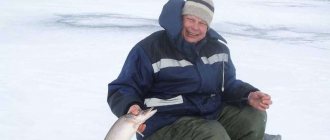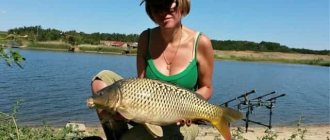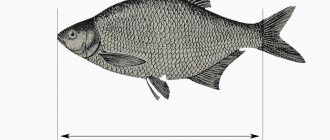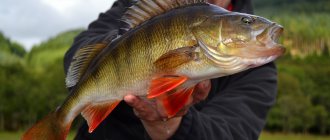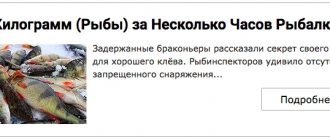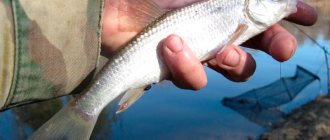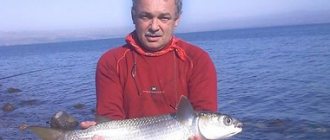Where, when and how much can Sal fishermen fish?
The questions are answered by the senior state inspector of the Nizhnedonsky department of state control, supervision and protection of the Azov-Black Sea TU Rosrybolovstvo Viktor Doroshenko
- Viktor Viktorovich, with the arrival of spring the season of mass amateur and sport fishing opens, and many readers would like to know the existing restrictions so that the enjoyment of fishing does not turn into unpleasant consequences.
— Let's start with the prohibitions defined by the Fishing Rules. First, let’s understand the concept of “areas prohibited for the extraction (catch) of aquatic biological resources.” The concept of “areas” must be understood as isolated places, parts of a reservoir, or entire reservoirs in water bodies of a fishing basin, where fishing bans have been introduced by the current Rules. No such prohibited areas have been defined for Salsky, as well as Proletarsky, Peschanokopsky, Tselinsky, Egorlyksky, Oryol, and Remontnensky administrative districts in public water bodies. Citizens have the right to carry out recreational and sport fishing in water bodies of public fishery importance freely and free of charge in accordance with the Fishery Rules. These citizens are prohibited from fishing within the boundaries of fish-breeding areas without the consent of fish farms - users of fish-breeding areas and outside the places indicated by users of fish-breeding areas, indicated by the corresponding notices. That is, if users have identified such places and designated them as full houses, in this case it is possible to carry out amateur and sport fishing only for those species that are present in almost all reservoirs. These are aquatic species - crucian carp, ram, roach, bream, rudd, perch, pike perch, etc.
— Tell us about the periods (periods) prohibited for the extraction (catch) of aquatic biological resources, in relation to the south-eastern administrative regions of the Rostov region.
— From January 1 to June 14, catching freshwater crayfish in water bodies of the Rostov region is prohibited, excluding the Tsimlyansk Reservoir; from December 1 to April 30 - catching pike perch and bersh in the Veselovsky and Proletarsky reservoirs; from January 15 to February 28 (29) - pike fishing everywhere in all reservoirs of fishery importance in the Rostov region; from March 15 to April 30 - catching pike perch everywhere in all reservoirs of fishery importance in the Rostov region; from April 15 to June 15 - fish catching. During the prohibited period from April 1 to May 31, when carrying out amateur and sport fishing, it is prohibited to move along rivers, lakes, reservoirs and channels in all types of small and recreational vessels using motors; use small and recreational vessels during the prohibited period on water bodies of fishing significance (or areas thereof) specified in Appendix No. 2 to the Fishery Rules “ List of water bodies of fishing significance (or their areas) on which the use of small and recreational vessels is prohibited during the prohibited period ", with the exception of non-self-propelled vessels, as well as other vessels used to carry out permitted activities for the extraction (catch) of aquatic biological resources.
— Name the types of aquatic biological resources prohibited for production (catch), which apply to the entire Azov-Black Sea fisheries basin.
— These are marine mammals, sturgeon species of fish, Black Sea salmon, shemaya, light croaker, gurnard, carp, flounder, lampreys, oysters, Black Sea crabs, pearl mussels, Russian bystryanka, common sculpin, female freshwater crayfish bearing eggs and larvae; species of fish grown for the purposes of aquaculture (fish farming) - in fish breeding areas provided for use by fish farms. In the case of production (catch) of prohibited species of aquatic biological resources, they must be released into the habitat with the least damage, regardless of their condition.
— Perhaps the most common question from Sal amateur fishermen is: what species and how many can one amateur fisherman catch during the day?
— Let's present the answer to this question in the form of a table. It will be clearer this way.
The total daily production rate per fisherman for all types of aquatic biological resources indicated in the table is no more than 5 kg or one specimen if its weight exceeds 5 kg.
— How to determine the commercial size of aquatic biological resources, that is, length in centimeters?
- In fish - by measuring the length from the top of the snout (with the mouth closed) to the base of the middle rays of the caudal fin; in crustaceans - the body from the line connecting the middle of the eyes to the base of the tail plates. Extracted aquatic biological resources having a length less than that indicated in the table are subject to immediate release into the natural habitat with the least damage. I will also say that silver crucian carp, carp, rudd, perch and other species not included in the table are not limited to catch individually, the fishing length is not measured and the total catch in weight measurement does not apply to them.
— How much and what can an ordinary fisherman have with him?
— For amateur and sport fishing, it is permitted for one citizen to use: fishing rods (including bottom fishing rods) and spinning gear of all systems and types with a total number of hooks (single, double or triple) of no more than ten pieces; lifters (“spiders”) and scoops of no more than one piece, with a size (length, width, height) of more than 100 cm, and a mesh size (pitch) of no more than ten mm (including those used with bait) for catching live bait (bait), except for particularly valuable and valuable fish species; circles and girders with a total number of hooks (single, double or triple) of no more than ten pieces per fishing (catch) gear; no more than five crayfish with the parameters permitted by the Fishing Rules; using the gill method (using bagasse traps, “harvesters”) with no more than one single hook. In conclusion, I will add that amateur and sport fishing can be carried out in public waters throughout the calendar year in compliance with the current norms and Rules, the main part of which I explained in this article. Next time I will tell you about the new fees for calculating damage to aquatic biological resources. Taking this opportunity, I would like to wish all readers a favorable fishing season and a healthy holiday.
Fishing: we continue to explain fishing rules to Sal residents
/* */?> April 15 11:32 2021 author admin Print 3988
Senior state inspector of the Nizhnedonsky department of state control, supervision and protection of the Azov-Black Sea TU Rosrybolovstvo Viktor Doroshenko continues to answer fishermen’s questions
— Viktor Viktorovich, judging by the reviews, your last interview turned out to be very useful for Salsky amateur fishermen. Therefore, let's continue our conversation. So, newspaper readers have many questions when traveling in their cars to bodies of water for the purpose of recreation and recreational fishing. What are the current restrictions?
— In accordance with Article 6 of the Water Code of the Russian Federation dated June 3, 2006 No. 74-FZ, surface water bodies that are in state or municipal ownership are water bodies of public use, that is, publicly accessible water bodies, unless otherwise provided by this Code. Every citizen has the right to have access to public water bodies and use them free of charge for personal and domestic needs, unless otherwise provided by this Code and other federal laws. The use of public water bodies is carried out in accordance with the rules for the protection of human life on water bodies, approved in the manner determined by the authorized federal executive body, as well as based on the established rules for the use of water bodies for personal and domestic needs by local government bodies. Every citizen has the right to use (without the use of motor vehicles)
coastal strip of public water bodies for movement and stay near them, including for recreational and sport fishing. In other words, you can walk on foot along the coastal strip and fish in public waters, relax using the coastal strip, unless otherwise provided by the same Code or other Federal laws. Next, it is necessary to take into account the requirements of Article 65 of the Water Code of the Russian Federation, which gives the concept of what a water protection zone and coastal protective strip are, according to which water protection zones are territories that are adjacent to the coastline (borders of a water body) of seas, rivers, streams, canals , lakes, reservoirs and on which a special regime of economic and other activities is established in order to prevent pollution, clogging, siltation of water bodies and depletion of their waters, as well as to preserve the habitat of aquatic biological resources and other objects of flora and fauna. Within the boundaries of water protection zones, coastal protective strips are established, on the territory of which additional restrictions on economic and other activities are introduced, that is, a more demanding approach is determined when using it.
The answer to the question of interest to citizens is determined by paragraph 4, part 15, article 65 of the Water Code of the Russian Federation, according to which the movement and parking of vehicles (except for special vehicles) within the boundaries of water protection zones and coastal protective strips is prohibited, with the exception of their movement on roads and parking on roads and in specially equipped places with hard surfaces. What does it mean? If you want to go to a body of water for any purpose in your vehicle, it doesn’t matter whether it’s a car, a tractor or a motorcycle, you need to make sure whether there is a hard surface along the shore or a parking lot with a hard surface (asphalt, concrete or compacted crushed stone-gravel, etc.) within the boundaries of the water protection zone, and also know how wide this zone is in relation to a given reservoir.
- And what is it like?
— The width of water protection zones of rivers or streams is established from their source with a length of: up to 10 km - in the amount of 50 meters; from 10 to 50 km - in the amount of 100 meters; from 50 km and more - in the amount of 200 meters.
It is also necessary to remember this: the width of the water protection zone of a lake or reservoir, with the exception of a lake located inside a swamp, or a lake or reservoir with a water area of less than 0.5 square kilometers, is set at 50 meters; The width of the water protection zone of a reservoir located on a watercourse is set equal to the width of the water protection zone of this watercourse, and the width of the water protection zone of main or inter-farm canals coincides in width with the allotment strips of such canals. These requirements must be taken into account when choosing the direction of upcoming movement or parking.
As for the Middle Yegorlyk, the water protection zone of this river on both sides is 200 meters. The presence of any obstacles, for example, a field located 50 meters from the coastline (the border of a water body), does not give reason to neglect the requirements of this legal norm!
— What is the size of the fine for this violation?
— For violation of the special regime of water use (this is the main definition of violation), liability is provided under Part 1 of Article 8.42 of the Code of Administrative Offenses of the Russian Federation. The sanction of this article for citizens is an administrative fine in the amount of 3,000 to 4,500 rubles.
— What can you tell readers about the new fees for fishing in violation of the current Fishing Rules?
— Resolution of the Government of the Russian Federation dated November 3, 2018 No. 1321 approved new rates for calculating the amount of damage caused to aquatic biological resources, which have increased significantly. See the numbers in the table.
NEW FEES FOR CALCULATING THE AMOUNT OF DAMAGE CAUSED TO AQUATIC BIORESOURCES
| Aquatic biological resources | Tax for 1 copy (in rubles) | |||
| until November 2021 | after November 2021 and up to now | |||
| Zander | 250 | 3305 | ||
| Carp | 250 | 925 | ||
| Carp | 250 | 925 | ||
| Pike | 250 | 925 | ||
| White amur | 250 | 925 | ||
| Silver carp | 250 | 925 | ||
| Freshwater catfish | 250 | 925 | ||
| Bersh | 250 | 500 | ||
| Taran | 25 | 500 | ||
| Bream | 25 | 500 | ||
| Gustera | 100 | 500 | ||
| Channel catfish | 250 | 250 | ||
| Roach | 50 | 250 | ||
| crucian carp | 10 | 250 | ||
| Freshwater perch | 17 | 250 | ||
| Cancers | 42 | 115 | ||
As for crucian carp, I will say that liability only arises if the fish in question was caught using prohibited fishing gear. You can catch any quantity with a fishing rod!
According to Note 1 of the Decree of the Government of the Russian Federation dated November 3, 2018 No. 1321, when calculating damage caused to aquatic biological resources during periods prohibited for fishing and (or) in areas prohibited for fishing, which are established in accordance with the Federal Law “On Fisheries and conservation of aquatic biological resources”, in addition to the fees provided for by this Resolution, 100 percent of the fee per specimen (kilogram) of the corresponding species (subspecies) is taken into account, that is, twice the amount.
In order to avoid significant expenses, it would not be amiss to recall that every amateur fisherman has a chance to not be subject to a fine and possible damage. That is, having determined that fish or crayfish that do not meet the requirements of the Fishery Rules for the Azov-Black Sea Fishery Basin No. 293 dated 01.08.2013 (as amended on 29.11.2017), should be released into the natural environment with the least damage, regardless of their condition a habitat. But if the obtained (caught) fish specimens are placed in a cage or in another container or simply left on the shore, liability in this case cannot be avoided!
In conclusion, I would like to wish all amateur fishermen of the Salsky region successful fishing without unpleasant memories from meeting with state fishery inspectors.
Svetlana Omelyanovich, 8(86372) 7-10-22,
[email protected]
Photo — ribalka.guru
salsknews.ru
Article tags: 2019salsknewsRostov regionSalskSalsk newsSalsk Nyussalsky districtsalsknews
Categories:
SocietyEcology
General forecast for biting peaceful and predatory fish in the city of Salsk (Russia)
Good moon phase for peaceful fish: excellent bite for peaceful fish.
Good moon phase for predatory fish: excellent bite for predatory fish.
Good moon phase for peaceful fish: excellent bite for peaceful fish.
Good moon phase for predatory fish: excellent bite for predatory fish.
Good moon phase for peaceful fish: excellent bite for peaceful fish.
Good moon phase for predatory fish: excellent bite for predatory fish.
Good moon phase for peaceful fish: excellent bite for peaceful fish.
Good moon phase for predatory fish: excellent bite for predatory fish.
BITING FORECAST FOR PEACEFUL FISH IN THE CITY OF SALSK
Today - Friday - nightBite of peaceful fishPositive factors: + Good phase of the moon for peaceful fish: excellent bite of peaceful fish. + As a rule, a little rain can activate the fish bite. + A slight breeze is very favorable for fishing. + Low atmospheric pressure has a beneficial effect on fish biting. + Stable low atmospheric pressure.
Negative factors: - At this time of year, fish, as a rule, do not bite. You can count on a normal bite from bream and roach. — As a rule, fish stop biting during northern and eastern winds. — The wind changes often and it’s a bad time for fishing.
Today - Friday - morningBite of peaceful fish Positive factors: + Good phase of the moon for peaceful fish: excellent bite of peaceful fish. + The fish bite is better on grey, cloudy days. + Good fish bite when the wind blows from the west, south, east. + A slight breeze is very favorable for fishing. + Low atmospheric pressure has a beneficial effect on fish biting. + Stable low atmospheric pressure.
Negative factors: - At this time of year, fish, as a rule, do not bite. You can count on a normal bite from bream and roach. — The wind changes often and it’s a bad time for fishing.
Today - Friday - day Biting peaceful fish Positive factors: + Good phase of the moon for peaceful fish: excellent biting peaceful fish. + As a rule, a little rain can activate the fish bite. + Good fish bite when the wind blows from the west, south, east. + A slight breeze is very favorable for fishing. + Low atmospheric pressure has a beneficial effect on fish biting. + Stable low atmospheric pressure.
Negative factors: - At this time of year, fish, as a rule, do not bite. You can count on a normal bite from bream and roach. — The wind changes often and it’s a bad time for fishing.
Today - Friday - eveningBite of peaceful fishPositive factors: + Good phase of the moon for peaceful fish: excellent bite of peaceful fish. + The fish bite is better on grey, cloudy days. + Good fish bite when the wind blows from the west, south, east. + A slight breeze is very favorable for fishing. + Atmospheric pressure is normal for fish. + Stable atmospheric pressure.
Negative factors: - At this time of year, fish, as a rule, do not bite. You can count on a normal bite from bream and roach. — The wind changes often and it’s a bad time for fishing.
Tomorrow - Saturday - nightBite of peaceful fish Positive factors: + Good phase of the moon for peaceful fish: excellent bite of peaceful fish. + In clear weather, as a rule, the fish feels comfortable. + Today the direction of the wind does not affect the fish bite. + A slight breeze is very favorable for fishing. + Atmospheric pressure is normal for fish. + Stable atmospheric pressure.
Negative factors: - At this time of year, fish, as a rule, do not bite. You can count on a normal bite from bream and roach. — The wind changes often and it’s a bad time for fishing.
Tomorrow - Saturday - morningBite of peaceful fishPositive factors: + Good phase of the moon for peaceful fish: excellent bite of peaceful fish. + In clear weather, as a rule, the fish feels comfortable. + A slight breeze is very favorable for fishing. + Stable wind direction. + Atmospheric pressure is normal for fish. + Stable atmospheric pressure.
Negative factors: - At this time of year, fish, as a rule, do not bite. You can count on a normal bite from bream and roach. — As a rule, fish stop biting during northern and eastern winds.
Tomorrow - Saturday - day Biting of peaceful fish Positive factors: + Good phase of the moon for peaceful fish: excellent biting of peaceful fish. + The fish bite is better on grey, cloudy days. + A slight breeze is very favorable for fishing. + Stable wind direction. + Atmospheric pressure is normal for fish. + Stable atmospheric pressure.
Negative factors: - At this time of year, fish, as a rule, do not bite. You can count on a normal bite from bream and roach. — As a rule, fish stop biting during northern and eastern winds.
Tomorrow - Saturday - eveningBite of peaceful fish Positive factors: + Good phase of the moon for peaceful fish: excellent bite of peaceful fish. + The fish bite is better on grey, cloudy days. + A slight breeze is very favorable for fishing. + Stable wind direction. + Atmospheric pressure is normal for fish. + Stable atmospheric pressure.
Negative factors: - At this time of year, fish, as a rule, do not bite. You can count on a normal bite from bream and roach. — As a rule, fish stop biting during northern and eastern winds.
03/01/2020 - Sunday - night Biting of peaceful fish Positive factors: + Good phase of the moon for peaceful fish: excellent biting of peaceful fish. + As a rule, a little rain can activate the fish bite. + A slight breeze is very favorable for fishing. + Stable wind direction. + Atmospheric pressure is normal for fish. + Stable atmospheric pressure.
Negative factors: - Due to the lack of oxygen in the water, fish of all species remain passive. You can count on a stable bite of bream and roach. — As a rule, fish stop biting during northern and eastern winds.
03/01/2020 - Sunday - morningBite of peaceful fishPositive factors: + Good phase of the moon for peaceful fish: excellent bite of peaceful fish. + As a rule, a little rain can activate the fish bite. + A slight breeze is very favorable for fishing. + Stable wind direction. + Atmospheric pressure is normal for fish. + Stable atmospheric pressure.
Datalife Engine Demo
In the Rostov region it flows and is lost in the vast Salskie
in the steppes the Manych River is quiet, masked by a high wall of reeds. Few people, except Rostov and partly Ukrainian fishermen, know about the fishing Eldorado of the Manych channels and reservoirs. In winter, here you can attack a school of perch, in which there are specimens reaching 2.5 kg. Such humpback whales barely fit into the hole from the wide Leningrad ice auger. Pike can also be large in size - sometimes in the pits of reservoirs, fishermen remove 17-kilogram predators from the girders. And pike weighing 2-4 kg are common here, especially in shallow bays overgrown with grass. In the Manych reeds you can even watch for carp in clearings of clean water mowed down by muskrats. You just have to feed the place with cake, or, as they call it here, makukha. The Manych bays are surprisingly rich in a wide variety of fish. Along with large tench, here you can find asp and sabrefish, ide and vimba, catfish and burbot, pike perch and bersh, bream and silver bream.
There is a lot of bream in the Manych reservoirs Proletarsky and Veselovsky. But here he is extremely capricious in biting and cautious. In winter and summer, fishermen in the reservoir catch large roach and silver bream, rudd and silver crucian carp and very rarely bream, while on the collective farm the local fishing crew sometimes selects dozens of centners of this fish from the net within an hour. Large roach, known locally as ram, is perhaps the most popular object of winter fishing here. When the ram is biting at the fishing base of the Veselovsky Reservoir, as they say, there’s nowhere for an apple to fall - amateurs come from all the surrounding regions and even from the shores of the Crimea and the Caucasus. The winter ram bite is a real holiday: if you look at the 80-kilometer reach of the Veselovsky reservoir from the helicopter window, you can see dozens of buses and cars on the shore and thousands of fishermen on the ice. The fish are not particularly picky about bait, which indicates a relatively poor food supply in the reservoir. And if visiting fishermen bring bloodworms, maggots, and pieces of lung, then the locals are good at catching rams using colored pieces of dough. In terms of weight, the Manych ram can compete with the best Volga roach; before my eyes, specimens up to 1 kg 300 g were pulled out, and the rangers of fishing bases monitoring the catches of anglers say that even larger fish are caught. Where else if not here to look for record fish?!
Catching predators in the winding multi-kilometer bays of the Veselovsky reservoir is also very interesting. At depths of up to 5-7 m, there is plenty of room for road warriors and fans of sheer trolling. Using the latter method, you can catch not only pike perch, but also catfish. If you ask a Rostov spinner what fish he prefers, he will probably answer perch. Manych humpback whales will also bring you many pleasant moments. Getting to these places is quite simple: you fly to Rostov-on-Don and, near the airport, take a bus at the bus station going to the Vesely village (4-5 flights per day), located at the very beginning. The Veselovsky reservoir, which is connected to another, no less extensive Proletarsky reservoir. You can also get to the center of the Veselovsky reservoir by bus or train Rostov - Volgodonsk to Salsk, and then to the villages of Frunze or Russky, located on the very shore of large bays. You can also travel to the Proletarskoye Reservoir by train Rostov - Volgodonsk to Proletarskaya station. In large villages there are hotels, in small villages you can stay with local residents, especially fishermen, who here are distinguished by hospitality no less than that of the Caucasus. There are several fishing bases along the banks of the Veselovskoye Reservoir, where you can have a good rest, take a boat and consult with the rangers, who always warmly welcome guests.
Sal fishermen answered their most popular questions
/* */?> January 10 08:00 2021 author admin Print 4518
The Rostov region is a real paradise for fishing lovers. People fish here both on the river and at sea, and this can be done at any time of the year. The variety of fish is truly amazing, despite the fact that over the past decades sturgeon have almost completely disappeared, and the delicious shemaya was only excluded from the Red Book in April 2021, but people are still fined for catching it. Today we are in touch with the state inspector of the Nizhnedonsky fisheries protection department of the Azov-Black Sea TU Rosrybolovstvo Viktor Doroshenko, who spoke about the best places for catching fish, answered questions about what kind and how much you can catch at one time...
— Viktor Viktorovich, so what rules does a simple fisherman need to know?
— Free fishing in the Rostov region in 2021 is possible in three main rivers: Don, Northern Donets and Manych, as well as on other small rivers and reservoirs, of which there are more than four hundred.
Fishing in the Rostov region from 2021 takes place according to the updated Fishing Rules for the Azov-Black Sea fishery basin (Order of the Ministry of Agriculture of Russia No. 1 of 01/09/2020). When citizens engage in recreational fishing, it is still not possible to apply
networks of all types; traps of all types and designs, with the exception of crayfish traps, the use of which is permitted for catching crayfish in freshwater bodies; passive fishing gear on rivers that are habitat for trout; fishing rods (including bottom fishing rods) and spinning gear of all systems and types with a total number of hooks (single, double or triple) of more than 10 pieces per citizen; trawling and dredging mining (fishing) gear; straining and netting mining (fishing) gear and devices, with the exception of lifts and scoops, no more than one piece per citizen, size (length, width, height) no more than 100 cm and size (step) meshes of no more than 10 mm (including those used with bait) for the production (catch) of live bait (bait), except for especially valuable and valuable species of fish; traps, self-catching (red-head) hook tackle; piercing fishing tools (catch), with the exception of amateur fishing carried out using special pistols and guns for underwater hunting; firearms and pneumatic weapons, crossbows and bows; mining (catch) gear that affects aquatic biological resources with electric current, as well as explosive, toxic, narcotic drugs (substances) and other mining (catch) gear prohibited by the legislation of the Russian Federation.
— What fishing methods are banned?
— It is forbidden to extract (catch) aquatic biological resources using the following methods: the method of grappling, silencing, rutting (including using rattles and bogging); by saddles; for illumination - using lighting devices and lanterns of various designs from the surface and in the water column at night (astronomical, from sunset to sunrise) time of day for the extraction (catch) of aquatic biological resources, with the exception of fishing using fishing rods (including including bottom fishing rods) and spinning gear of all systems and names, as well as crayfish traps; on the track - using a rowing vessel or floating craft using more than two baits per vessel or floating craft; for trolling - using a sail and (or) motor using more than two baits per vessel or floating craft; circles and girders with a total number of hooks (single, double or triple) of more than 10 pieces on the fishing gear of one citizen; by installing driveways, fences, pins, dams and other types of barriers that partially or completely block the bed of water bodies and prevent the free movement of fish; more than five crayfish traps per citizen, each of the parameters of permitted crayfish traps (length, width, height - for polygonal ones, height, diameter - for conical and cylindrical ones) should not exceed 80 cm; using the gill method (using bagasse traps, harvesters) with more than one single hook; freshwater crayfish by wading or diving.
Citizens are prohibited from independently seizing equipment for the extraction (catch) of aquatic biological resources found in water bodies of fishery significance that is prohibited by the Fishery Rules, as well as aquatic biological resources located in such extraction (catch) gear. Persons who discover such equipment for the extraction (catch) of aquatic biological resources must notify the state authorities authorized to exercise federal state control (supervision) in the field of fishing and conservation of aquatic biological resources and (or) state control in the field of protection of marine biological resources about this fact.
— What else do amateur fishermen need to remember?
— When going fishing, citizens should remember the areas prohibited for the extraction (catch) of aquatic biological resources; on periods prohibited for the extraction (catch) of aquatic biological resources and on prohibited types of aquatic biological resources, including those listed in the Red Book of the Russian Federation and the Red Books of the constituent entities of the Russian Federation, established by the Fishery Rules for the Azov-Black Sea fishery basin (Order of the Ministry of Agriculture of Russia No. 1 of 01/09/2020, which entered into force on 03/24/2020).
It is also necessary to remember and observe the minimum size for each type of extracted (caught) aquatic biological resources, with the exception of species not included in the tables of the Fishing Rules. When carrying out recreational fishing, it is prohibited to permanently withdraw aquatic biological resources that have a fresh length less than that specified in Table 19 (commercial size):
Table 19
| Name of aquatic biological resources | Length, cm |
| Pike perch in other water bodies of fishery importance | 38 |
| Freshwater catfish | 60 |
| Carp | 35 |
| Taran | 16 |
| Rybets, raw | 22 |
| Sinets | 24 |
| white cupid | 45 |
| Bream in the Sea of Azov, Taganrog Bay, in the Don River | 28 |
| Bream in other freshwater bodies of fishery importance | 24 |
| Bream in the Tsimlyansk Reservoir | 27 |
| Brown trout (freshwater resident form) | 15 |
| Barbels | 20 |
| Podust | 15 |
| Bersh | 26 |
| Asp | 35 |
| Silver carps | 50 |
| Chekhon | 24 |
| Black Sea-Azov herring, migratory and sea herring | 15 |
| Pilengas | 38 |
| Chub in other water bodies of fishery importance | 28 |
| Tench | 17 |
| Pike | 30 |
| Ide | 26 |
| Gobies | 10 |
| Crayfish (freshwater crayfish) | 9 |
| Crayfish (freshwater crayfish) in the Tsimlyansk Reservoir | 10 |
The commercial size of aquatic biological resources is determined in fresh form: for fish - by measuring the length from the top of the snout (with the mouth closed) to the base of the middle rays of the caudal fin; in crustaceans, by measuring the body from a line connecting the middle of the eyes to the end of the tail plates. Extracted (caught) aquatic biological resources having a length less than that specified in subclause 50.1 of the Fishery Rules are subject to immediate release into the natural habitat with the least damage.
— Many people are interested in the question, how many fish can you catch at one time?
— The daily rate of production (catch) of aquatic biological resources (except for the case where such aquatic biological resources are subject to a permanent or temporary ban on production (catch) during recreational fishing) for one citizen during recreational fishing is indicated in Table 19.1.
Table 19.1
| Name of aquatic biological resources | Daily rate of production (catch), kg/individual. |
| Zander | 2 copies |
| Freshwater catfish | 2 copies |
| Carp | 3 copies |
| Garfish | 5 kg |
| Taran | 5 kg |
| Rybets, raw | 5 copies |
| Sinets | 5 kg |
| white cupid | 2 copies |
| Bream | 5 kg |
| Brown trout (freshwater resident form) | 5 copies |
| Barbels | 5 kg |
| Podust | 5 kg |
| Bersh | 5 copies |
| Asp | 3 copies |
| Silver carps | 2 copies |
| Chekhon | 5 kg |
| Black Sea-Azov herring, migratory and sea herring | 5 kg |
| Azov belly | 5 kg |
| Pilengas | 5 kg |
| Chub | 5 kg |
| Tench | 5 kg |
| Pike | 5 kg |
| Ide | 5 kg |
| Gobies | 5 kg |
| Flounder-kalkan | 2 copies |
| Flounder glossa | 5 kg |
| Mullet (singil, mullet, pointed nose) | 5 kg |
| Horse mackerel | 5 kg |
| Roach | 5 kg |
| Gustera | 5 kg |
| Perch | 5 kg |
| Rudd | 5 kg |
| Common crucian carp | 5 kg |
| Silver crucian carp | 10kg |
| Gudgeon | 5 kg |
| Burbot | 5 kg |
| White-eye | 5 kg |
| Dace | 2 copies |
| Ruff | 5 kg |
| Bleak | 5 kg |
| Verkhovka | 5 kg |
| Cupid black | 2 copies |
| Crayfish (freshwater crayfish) | 30 copies |
| Black Sea shrimp | 2 kg |
| Artemia (including at the cyst stage) | 0.2 kg |
| Chironomidae | 0.5 kg |
| Polychaetes | 0.5 kg |
The total daily production (catch) rate for all types of aquatic biological resources (except for rapana and crucian carp) indicated in Table 19.1 is no more than 5 kg or one specimen if its weight exceeds 5 kg. Extraction (catch) of aquatic biological resources is permitted in the amount of no more than one daily norm when staying on a water body for one day. In case of stay on a water body for more than one day, regardless of the time of stay on the water body, production (catch) of aquatic biological resources is permitted in the amount of no more than two daily production (catch) norms. If the daily norm is exceeded, production (catch) of all types of aquatic biological resources permitted for production (catch) is stopped.
— What other prohibitions exist?
— When arriving at a reservoir and carrying out recreational fishing, citizens are prohibited from: throwing away or releasing the extracted aquatic biological resources permitted for extraction, with the exception of recreational fishing, carried out with the subsequent release of the extracted (caught) aquatic biological resources into the natural habitat in a living form with the least damage (hereinafter — fishing on the “catch and release” principle); move along rivers, lakes, reservoirs and their channels on all types of small and pleasure craft using motors during prohibited periods (periods) and in prohibited places, with the exception of the use of motorized vessels and floating craft for fishing under permits for the extraction (catch) of aquatic biological resources; use small-size and recreational vessels during the prohibited period on water bodies of fishing significance (or their areas) specified in Appendix No. 2 to the Fishery Rules “List of water bodies of fishing significance (or their areas) on which the use of small-size and recreational vessels is prohibited during the prohibited period ", with the exception of non-self-propelled vessels, as well as other vessels used to carry out permitted fishing activities; stop the access of oxygen and water to a water body of fishery importance by destroying its water supply sources, as well as drain water bodies of fishery importance for the purpose of extracting (catching) aquatic biological resources (with the exception of ponds for commercial fish farming, located outside the beds of natural watercourses and equipped with hydraulic structures, regulating the supply and discharge of water). Pollution of water bodies of fishery importance and deterioration of the natural habitat conditions of aquatic biological resources, as well as spoiling and destroying warning signs and signs in fish protection zones of water bodies of fishery importance must not be allowed.
— Who should I contact if I have any questions?
— Please note that this article contains the main, but not complete, list of restrictions related to the implementation of recreational fishing by citizens in reservoirs of fishery importance in the Rostov region. Therefore, for all emerging questions related to the implementation of recreational fishing in 2021, citizens can seek clarification during business hours from 09.00 to 18.00 by calling the Proletarian Fishery Inspectorate: +7-(863)-74-9-67-85, or by calling telephone hotline of the Azov-Chernomorsky TU Rosrybolovstvo: 8-938-148-44-42 (24 hours a day).
Signs of a successful bite
Due to popular demand, we present to your attention the fishing calendar for 2021. It was compiled based on the experience of previous years, including correlations with climate change, expected dates for opening gates, and the introduction of fishing bans in certain areas and even entire rivers.
A fishing calendar for 2021 was also adopted for the Rostov region based on the species composition and fishing period of the designated fish. This calendar was developed two years ago, but meets today’s standards according to all criteria.
The fisherman’s calendar is an important thing, no doubt, but weather conditions, direct human actions, and various incidents make their contribution. The calendar lets the fisherman know when spawning will begin approximately, pre-spawning and post-spawning fish feeding.
We also suggest paying attention to the important signs and features of catching this or that fish in the so-called folk fishing calendar.
Happy fishing, dear fellow fishermen!
Svetlana Omelyanovich, 8(86372) 7-10-22,
[email protected]
salsknews.ru
Article tags: 2020salsknewsSalsk news
Categories:
Ecology

